The Etruscan Sarcophagus of the Spouses: A Feast for the Dead
The Sarcophagus of the Spouses is considered to be one of the greatest masterpieces of Etruscan art. The Etruscans, who originated in Italy between the Arno and Tiber rivers, are well known for their terracotta sculptures and funerary art in the art history world. The Sarcophagus of the Spouses is perhaps the most famous example of Etruscan funerary art and dates back to the sixth century BC. Found at the Banditaccia necropolis in Caere, it can now be seen at the National Etruscan Museum in Rome. It gives us a fascinating insight into not only the Etruscan art world, but also Etruscan views on women’s place in society and life after death.
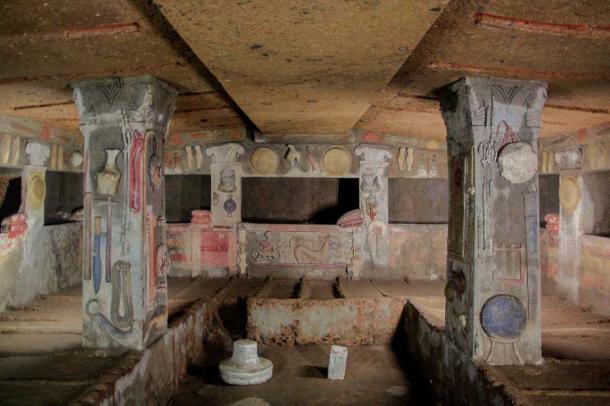
Interior of the Rilievi Tomb in the Banditaccia necropolis. (Roberto Ferrari / CC BY SA 2.0)
What is the Sarcophagus of the Spouses?
Made of terracotta, the Sarcophagus of the Spouses depicts a man and a woman reclining on a kline, a dining couch with cushions for comfort. The men and woman both have heavily stylized hair, plaited with braids. The woman’s braids hang stiffly at the sides of her neck. The proportions of their bodies are elongated, as was common in archaic period artworks. The couple is depicted as smiling, with almond-shaped eyes meant to give them a happy or content look. The man is barefoot, while the woman wears pointed shoes, an Etruscan characteristic.
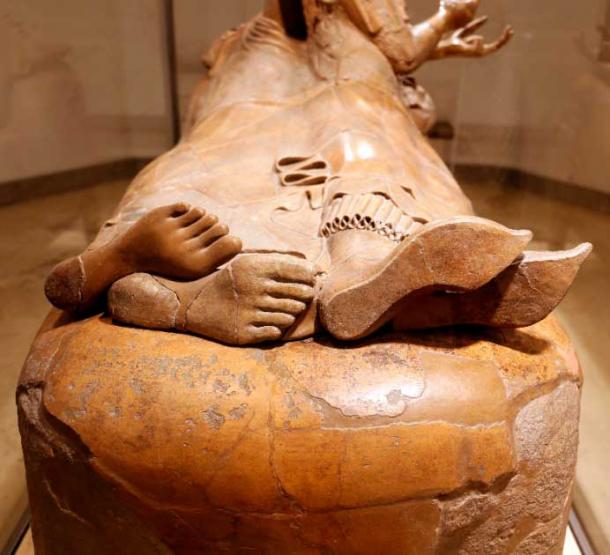
Close-up detail of the feet on the Sarcophagus of the Spouses (Sailko / CC BY SA 4.0)
In short, the sarcophagus depicts a seemingly happy couple lounging upon a comfortable sofa. Sadly, the couple’s hands have been damaged, and whatever they were holding has been lost. It can be assumed that they were either holding wine or food.
- Do not Underestimate the Etruscans: Art and Culture of their Own
- The Mysterious Ancient Etruscan Monuments of Selva di Malano
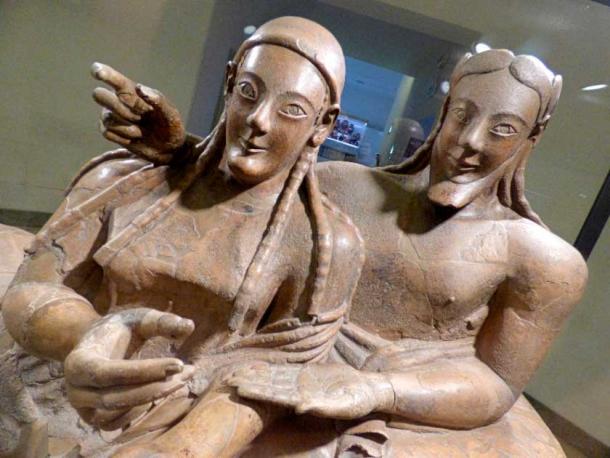
The man and woman on the Sarcophagus of the Spouses have gentle smiles, and both were original holding objects – perhaps making a toast to the afterlife. (Damien Entwistle / CC BY NC 2.0)
An Etruscan Funeral Banquet
The way the man and woman are reclining on the kline has prompted historians to surmise that the Sarcophagus of the Spouses originally belonged to a banqueting scene. Etruscan funerary art often depicted scenes of revelry and celebration, and the Sarcophagus of the Spouses appears to be no different.
It is thought the purpose of this art was to remind people of the traditional Etruscan funeral banquet. The Etruscans liked to go out with a celebration, and funerals often rejoiced in the life of the departed, rather than mourning their death. The Sarcophagus of the Spouses also reflects the idea that the afterlife was a place of conviviality and revelry in Etruscan culture. The funeral was only the start of the party for the recently deceased.
Unique Etruscan Attitudes towards Women
The Sarcophagus of the Spouses is useful in showing us how Etruscan attitudes toward women may have differed compared to those of their Greek neighbors, especially concerning how women were expected to act in public.
As can be seen from the sarcophagus, at these banquets it was common for men and women to recline and eat together in close proximity. The Greeks would have been shocked by this. In Greek culture, it would have been vanishingly rare for a woman to be allowed to even attend such an event, let alone cuddle up with her partner in public.
Indeed, the fact the sarcophagus features a woman at all would have been an oddity to the Greeks. During the archaic period, it was common to place a recumbent figure atop a sarcophagus. However, it was uncommon outside of Etruscan art to feature a female figure.
In comparison to their Greek counterparts, it was common for Etruscan women to take part in public life and attend events, such as banquets and parties. There is some evidence to indicate that Etruscan women of high social standing were seen as equals.
Etruscan women of high society were often literate. It was also believed that it was women who were responsible for carrying on the bloodline, as they carried and bore the children. This is different from many cultures, which see it as the male responsibility to carry on the bloodline.
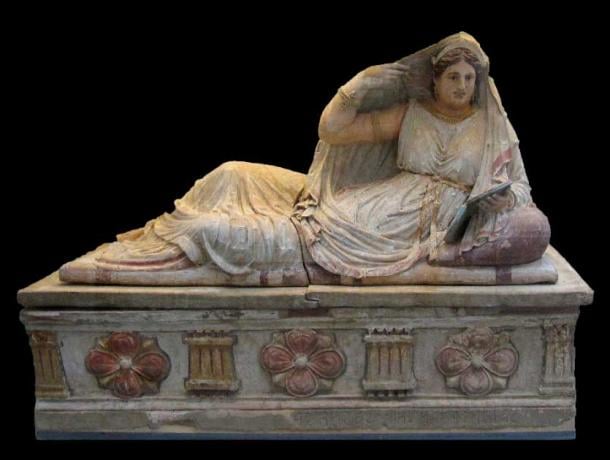
The life-sized sarcophagus of Seianti Hanunia Tlesnasa, an Etruscan noblewoman, circa 150 BC. Etruscan views on women’s role in society was quite different from their neighbors. (Gryffindor / CC BY SA 3.0)
The Technical Marvel of the Sarcophagus of the Spouses
The Etruscans were famed for their terracotta works, and the Sarcophagus of the Spouses is a technical masterpiece. The piece measures around 2 meters (6 feet) long, and sculpting its life-sized figures out of clay would have been no easy feat.
The Sarcophagus of the Spouses would have been time-consuming and immensely expensive to make. While we do not know who commissioned the piece, it surely would have been someone from the Etruscan’s highest social class.
The Etruscan artists of Cerveteri and Veii preferred working with clay which was highly refined when working on large-scale sculptures, such as the Sarcophagus of the Spouses. The clay's smooth surface made the application of paint and the addition of finishing touches that much easier. While the sarcophagus has lost its original paint job, myriad fine details are still evident.
Working with clay, however, becomes exponentially harder as the piece grows larger. This is why the sarcophagus was made out of multiple pieces; both the lid and body are bisected. This made it much easier for the artist to manipulate the clay both before and after firing. Viewed closely, a thin line can be seen separating the lovers from the bed they are reclining on. The two pieces were sculpted separately and then joined.
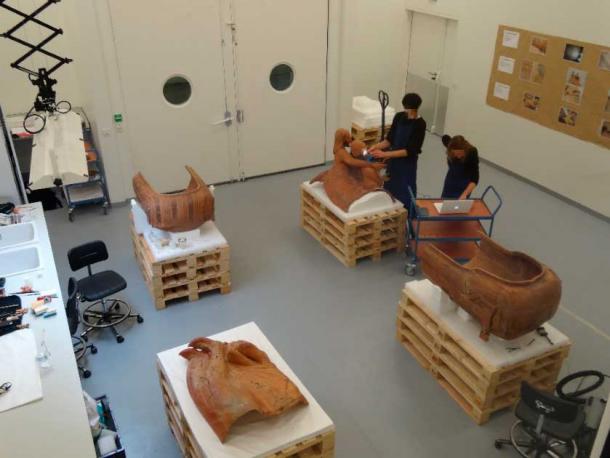
The four separate pieces of the Louvre Sarcophagus of the Spouses during restoration (Jérémy-Günther-Heinz Jähnick / GFDL 1.2)
Conclusion
The Sarcophagus of the Spouses is not just an impressive piece of artwork. It is a useful insight into Etruscan culture, which has historically often been overshadowed by that of the ancient Greeks and Romans.
Ancient Greece, with its democracy and wise philosophers, is often held up on a pedestal. Yet the sarcophagus is an important reminder that, in some ways, the Greeks lagged behind their Etruscan neighbors. The Etruscans in general seem to have had a much more favorable opinion of women. This is not to idolize the Etruscans, however; it is important to remember only high-born Etruscan women enjoyed such freedoms.
The Sarcophagus of the Spouses’ depiction of a funeral banquet is also fascinating. The Etruscans had a healthy attitude towards death and mourning. A funeral was not held to mourn the deceased, but to celebrate their life through good food and good wine. The Etruscans sent you off with a party, in the hope that the party would carry on into your afterlife. That doesn’t sound bad at all.
Top image: The Sarcophagus of the Spouses is an exquisite example of Etruscan art, and commentary on their society. Source: Sailko / CC BY SA 4.0
By Robbie Mitchell
References
Becker, J. August 8, 2015. Sarcophagus of the Spouses. Smart History. Available at: https://smarthistory.org/sarcophagus-of-the-spouses-rome/
Bonfante, L. 1986. Etruscan Life and Afterlife: a Handbook of Etruscan Studies. Wayne State University Press.
Macnamara, E. 1991. The Etruscans. Harvard University Press.
Taylor, L. 2012. Sarcophagus of the Spouses. Smart History. Available at: https://web.archive.org/web/20140215033007/http://smarthistory.khanacademy.org/the-sarcophagus-of-the-spouses.html



















